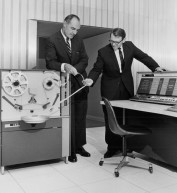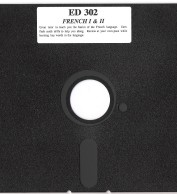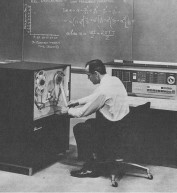STILLPOINT Archive: last updated 04/16/2008
Favorite IT (Information Technology) Memories and Artifacts
When we needed to identify a photograph of an artifact from the Ken Olsen archives, we asked Gordon computer science faculty and other IT specialists for their help. Our STILLPOINT inbox overflowed; the photo turned out to be of an antique magnetic core memory. Russ Leathe, director of networking and computer services, said the image "brought back a flood of memories" from his work at Wang Laboratories in the 1980s--including the morning he met An Wang in an elevator. "Here was the man who created electronic core memory and later revolutionized the industry with the first word processor, saying hi to me. If the founder of a multimillion dollar company can remember me, how much greater is the God Who created me." Here are more of our technology-savvy friends' favorite IT memories.
1 | The How and Why Wonder Book of Robots and Electronic Brains (1963)
The How and Why Wonder Book of Robots and Electronic Brains (1963) was the book that first interested me in computers. I read it about 100 times when I was in elementary school. I built robots out of light switches, light bulbs and big cardboard boxes. Isaac Asimov once quipped, when asked about the computers he had "invented" in his science fiction novels of the 1930s and '40s, "Did you notice I only described what it looked like on the outside?" My robots looked pretty good on the outside. Inside was me. I still have in my office my first computer, from the late 1970s, though actually my very first computer was the DigiComp I received around the same time as my How and Why Wonder Book. I'm still mourning the day it was unceremoniously thrown away. Now they're worth hundreds to collectors!
Irvin Levy, Ph.D.
Professor of Chemistry and
Computer Science
2 | IBM 1620
My first exposure to computers was through a summer program for high school students sponsored by the National Science Foundation at Illinois Institute of Technology in Chicago, my hometown. We had access to an IBM 1620 (an early minicomputer) and were actually allowed to sign up for hands-on time for an hour at a time. (I still can't figure out why they were willing to trust a bunch of high school students with a machine that probably cost more than a typical house at that time!) The 1620 was a decimal machine with 60,000 decimal digits of memory and a basic cycle time of 20 microseconds. It didn't have an operating system or mass storage. Instead, one loaded a program into memory from punched cards that had been prepared previously. It didn't have circuitry to perform arithmetic; instead, one had to load, add, and multiply tables into the memory when loading a new program. (IBM's internal name for the system during development was CADET, which some wag suggested meant "Can't Add-Don't Even Try.") I still have fond memories of that 1620. To this day I still know the machine language operation codes for several of the typical 1620 operations, though I haven't written a program on the machine in decades.
Russell Bjork, M.S.
Professor of Computer Science
3 | Punch-Card Memories
In 1983 I was hired by my undergraduate college to assist in computation for class scheduling. When a student registered for a class, the instructor handed over a punch card. At night I sat up with a PDP-11 as it processed over 10,000 punch cards (Ken Olsen's company, Digital Equipment Corporation, made these wonderful machines). By the next morning the registrar had an idea of who was scheduled for what classes. It was truly a miracle at the time. In 1986, during graduate school, I worked for Apple shortly after the Macintosh came out. I got an "insider's" deal on a Macintosh SE with 512 kilobytes of memory and 30 megabytes of hard disk space-it only cost me about $3,000. Today I have a new Macbook Pro with two gigabytes of memory and 160 gigabytes of disk space. It is much, much faster and cost less than $2,500. Recently I took the hard drive out of my dead Mac and stuck it in a Mac my sister-in-law was throwing out. When I started it up, it began processing right where it had left off over 10 years earlier.
Stephen Brinton, M.S.
Associate Professor of
Computer Science
4 | Black Spaghetti
Gordon's computer network used to consist of a series of telephone cables running from the "command center" in MacDonald Hall to the administrative offices in Frost. It was a joyous day when a grant made it possible to replace these telephone wires with a state-of-the-art Ethernet network connecting all the buildings on campus. As with most large projects, this one was slated for the summer. One day the workmen who were laying cables informed me that the conduit that held the telephone wires needed to be emptied ASAP and it "wasn't in their contract" to do that. Both Dave Sweet and Tom Borchart were on vacation, leaving it up to June Bodoni (director of the Center for Technology Services) and me to get the job done. June and I braced ourselves and started pulling black cable, hand over hand, while the workmen watched through the window and laughed. After several minutes we had a large quantity of black cable in the computer room. Sweaty but proud, we surveyed the pile of cable with a feeling of accomplishment. However, our flush of victory was short-lived; all that black spaghetti needed to be moved down the hall to MacDonald 107. Oops. We hadn't thought to coil it up as we went along. Now what? It was heavy, it was bulky, it was not cooperative. But we pulled it, pushed it and cajoled it, and eventually we got it down the hall. Dave and Tom had a good laugh when they got back, and June and I were then in high demand for any heavy-lifting jobs.
Anita Coco, M.R.E.
Media Support Specialist
5 | A Word Processor Named Abbey
One of my favorite tasks as a student working in Gordon's Alumni Office was running the thank-you letters and appeal letters on Gordon's first word processor. The A.B. Dick word processor (nicknamed Abbey by the Development Office) was a mammoth CPU connected to a huge daisy wheel typewriter with a tiny display screen. Abbey was located in a small remote office up a back staircase outside of Marv Wilson's office in Frost. There I could feed Abbey letterhead with one hand and hold a book with the other--the best student job ever. I read the entire Lord of the Rings trilogy that summer. I also took home the thick binder of instructions one weekend to learn how to program letters. That weekend my previously undiscovered "inner geek" came out. From there I went on to take a few programming classes, and I took every opportunity to read the VAX/VMS and POISE manuals. Eventually I got hired to do database management, which started my technology career at Gordon. I'll always have fond memories of Abbey and of Gordon's VAXes, which will be retired this year after many, many faithful years of service to the College.
June Bodoni '82, B.A.
Director of the Center for
Educational Technology
6 | A Gen X-er Remembers
As a member of Generation X, my entire life has been shaped by technology. When I was 5 years old, I sat next to my father, watching eagerly as he burned his own integrated circuit boards in a tub of acid with his Heath-Kit Poly 88 computer. When I was 10, my friend got a Timex Sinclair minicomputer that connected to the TV as a monitor (that concept died off quickly, but this convergence of television and computers is coming back into vogue). At Gordon I actually went through a phase of hating computers-they always seemed to lose my papers. But I was the first student to deliver a final term paper to a professor through email. I proudly toted my high-density 5¼-inch disk to the Computer Center, and they went right to work figuring out how to email the paper with the VAX system. Another area where technology has changed my life is with phones. Instead of answering the rotary dial phone attached to the wall in my childhood home, I now have no "land line," and the cell phone in my pocket has more computing power than my mid-1990s-era seminary desktop computer (of course I kept the classic ringing bell ring tone).
Robert Van Cleef '94, M.A.Th.
Technology Program Manager


